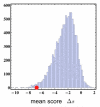Exome sequencing identifies frequent mutation of the SWI/SNF complex gene PBRM1 in renal carcinoma
- PMID: 21248752
- PMCID: PMC3030920
- DOI: 10.1038/nature09639
Exome sequencing identifies frequent mutation of the SWI/SNF complex gene PBRM1 in renal carcinoma
Erratum in
- Nature. 2012 Apr 5;484(7392):130
Abstract
The genetics of renal cancer is dominated by inactivation of the VHL tumour suppressor gene in clear cell carcinoma (ccRCC), the commonest histological subtype. A recent large-scale screen of ∼3,500 genes by PCR-based exon re-sequencing identified several new cancer genes in ccRCC including UTX (also known as KDM6A), JARID1C (also known as KDM5C) and SETD2 (ref. 2). These genes encode enzymes that demethylate (UTX, JARID1C) or methylate (SETD2) key lysine residues of histone H3. Modification of the methylation state of these lysine residues of histone H3 regulates chromatin structure and is implicated in transcriptional control. However, together these mutations are present in fewer than 15% of ccRCC, suggesting the existence of additional, currently unidentified cancer genes. Here, we have sequenced the protein coding exome in a series of primary ccRCC and report the identification of the SWI/SNF chromatin remodelling complex gene PBRM1 (ref. 4) as a second major ccRCC cancer gene, with truncating mutations in 41% (92/227) of cases. These data further elucidate the somatic genetic architecture of ccRCC and emphasize the marked contribution of aberrant chromatin biology.
Figures




Similar articles
-
Aberrant promoter hypermethylation of PBRM1, BAP1, SETD2, KDM6A and other chromatin-modifying genes is absent or rare in clear cell RCC.Epigenetics. 2013 May;8(5):486-93. doi: 10.4161/epi.24552. Epub 2013 May 1. Epigenetics. 2013. PMID: 23644518 Free PMC article.
-
The roles of chromatin-remodelers and epigenetic modifiers in kidney cancer.Cancer Genet. 2015 May;208(5):206-14. doi: 10.1016/j.cancergen.2015.02.008. Epub 2015 Feb 20. Cancer Genet. 2015. PMID: 25873528 Free PMC article. Review.
-
Clinical and pathological impact of VHL, PBRM1, BAP1, SETD2, KDM6A, and JARID1c in clear cell renal cell carcinoma.Genes Chromosomes Cancer. 2014 Jan;53(1):38-51. doi: 10.1002/gcc.22116. Epub 2013 Oct 29. Genes Chromosomes Cancer. 2014. PMID: 24166983
-
BAP1, PBRM1 and SETD2 in clear-cell renal cell carcinoma: molecular diagnostics and possible targets for personalized therapies.Expert Rev Mol Diagn. 2015;15(9):1201-10. doi: 10.1586/14737159.2015.1068122. Epub 2015 Jul 11. Expert Rev Mol Diagn. 2015. PMID: 26166446 Review.
-
Expression and Mutation Patterns of PBRM1, BAP1 and SETD2 Mirror Specific Evolutionary Subtypes in Clear Cell Renal Cell Carcinoma.Neoplasia. 2019 Feb;21(2):247-256. doi: 10.1016/j.neo.2018.12.006. Epub 2019 Jan 16. Neoplasia. 2019. PMID: 30660076 Free PMC article.
Cited by
-
ATF4/NUPR1 axis promotes cancer cell survival and mediates immunosuppression in clear cell renal cell carcinoma.Discov Oncol. 2024 Oct 31;15(1):607. doi: 10.1007/s12672-024-01485-0. Discov Oncol. 2024. PMID: 39480570 Free PMC article.
-
Opening and changing: mammalian SWI/SNF complexes in organ development and carcinogenesis.Open Biol. 2024 Oct;14(10):240039. doi: 10.1098/rsob.240039. Epub 2024 Oct 30. Open Biol. 2024. PMID: 39471843 Free PMC article. Review.
-
Therapeutic modulation of ROCK overcomes metabolic adaptation of cancer cells to OXPHOS inhibition and drives synergistic anti-tumor activity.bioRxiv [Preprint]. 2024 Sep 20:2024.09.16.613317. doi: 10.1101/2024.09.16.613317. bioRxiv. 2024. PMID: 39345502 Free PMC article. Preprint.
-
ARID1A-BAF coordinates ZIC2 genomic occupancy for epithelial-to-mesenchymal transition in cranial neural crest specification.Am J Hum Genet. 2024 Oct 3;111(10):2232-2252. doi: 10.1016/j.ajhg.2024.07.022. Epub 2024 Sep 2. Am J Hum Genet. 2024. PMID: 39226899 Free PMC article.
-
The influence of sex hormones on renal cell carcinoma.Ther Adv Med Oncol. 2024 Aug 21;16:17588359241269664. doi: 10.1177/17588359241269664. eCollection 2024. Ther Adv Med Oncol. 2024. PMID: 39175990 Free PMC article. Review.
References
-
- Kouzarides T. Chromatin Modifications and Their Function. Cell. 2007;128:693–705. - PubMed
Publication types
MeSH terms
Substances
Grants and funding
LinkOut - more resources
Full Text Sources
Other Literature Sources
Medical
Molecular Biology Databases
Miscellaneous


